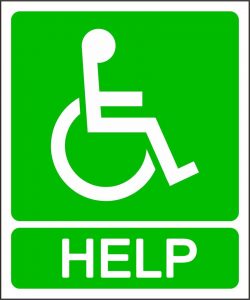If you see a car displaying a ‘help’ pennant on the hard shoulder of the motorway, then it is most likely to be a disabled driver who has broken down. Guidance for disabled drivers who cannot safely leave their vehicle if it breaks down on the motorway is to remain in the car with the hazard lights turned on. The guidance also advises that a disabled person can display a ‘help’ pennant when having to remain in the car. Once you have done this, the advice is for the disabled person to attempt to contact the emergency services using a mobile phone, if possible, or too wait for support to arrive if not.
What should you do if you see a ‘help’ pennant displayed on the hard shoulder?
If you see a ‘help’ pennant displayed on a car that has broken down on the hard shoulder of the motorway, you could consider stopping at the next service station to contact the emergency services and alert them. Alternatively, a passenger in your car could contact the emergency services to alert them to the situation. You should NOT contact them yourself whilst driving your vehicle. You should NOT stop on the hard shoulder yourself to offer help as this is against the law. Moreover, you are not required or expected to do any of these things.
Theory Test Question
Have you answered the question: You see a car on the hard shoulder of a motorway with a ‘help’ pennant displayed. What does this mean? Let’s consider each of the responses in turn to help you check your learning.
The driver is first-aid trained
Wrong! A driver who is first-aid trained would not be expected to behave in this way as you should not stop on the motorway hard shoulder except in an emergency.
The driver is likely to be a disabled person
Correct! If a disabled person breaks down and they are not able to walk to an emergency phone, then official advice is for them to remain in their car with the hazard lights switched on. They may also display a ‘help’ pennant if they have one in their vehicle.
The driver is a foreign visitor
Wrong! A driver who is a foreign visitor would not be expected to behave like this and should only be stopped on the hard shoulder if it is an emergency.
The driver is a rescue patrol officer
Wrong! Rescue patrol vehicles are indicated with amber flashing lights rather than a ‘help’ pennant.
Help Pennant Sign
A help pennant shows the wheelchair access symbol along with word ‘help’:
References
In section 15 of the official DVSA guide to driving, it states:
If you have any kind of mobility difficulty, you should stay in your vehicle and
- keep your seat belt fastened
- switch on your hazard warning lights
- display a ‘help pennant’ or use a mobile phone, if you have one in your vehicle, and be prepared to advise the emergency services of your location.
If you pass a broken-down vehicle displaying a ‘help pennant’, you may feel you should do something to help. However, you mustn’t stop and approach the vehicle. If you think the incident needs to be reported, you should leave the motorway or dual carriageway at the next exit or service area and report what you’ve seen, making sure you know the location of the vehicle before you call.
Rule 278 of the Highway Code states:
Disabled drivers. If you have a disability which prevents you from following the above advice you should
- stay in your vehicle
- switch on your hazard warning lights
- display a ‘Help’ pennant or, if you have a car or mobile telephone, contact the emergency services and be prepared to advise them of your location.



